
Torres Strait Finfish Daily Fishing Log - TSF02
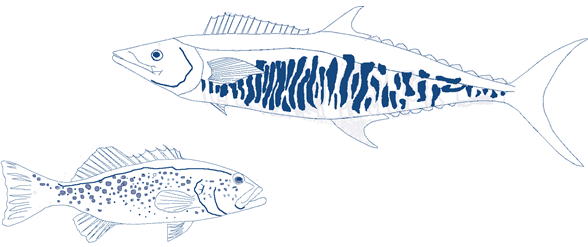
Vessel Name |
|
0231 |
Torres Strait Finfish Daily Fishing Log – TSF02
General Information and Instructions for Holders of Fishing Licences
![]()
This logbook is to be used when line fishing in the area of the Torres Strait Spanish Mackerel and Reef Line Fisheries. It is designed to provide a continuous record of fishing operations undertaken by Torres Strait licence holders.
Accurate data collected in this logbook is essential to provide information for research into and management of Torres Strait fisheries.
Important Information and Instructions
![]()
- This logbook must be completed for every day that the fishing licences are in force, regardless of whether or not fishing takes place on that day (see the “How to complete section).
- All logbook information must be recorded on a daily basis and details for the last day of the trip must be recorded before the boat unloads or leaves the area of the fishery.
- The pages in this logbook are self-carbonating. Please use a ballpoint pen when completing forms. Place the fold-out page divider under the original and duplicate pages to prevent writing transferring to the next set of forms.
![]()
- This logbook must be on board the boat during line fishing operations.
![]()
- The holder of the fishing licence is responsible for ensuring that this logbook is completed and that it is certified as complete and correct.
- The holder can do these things personally. Alternatively, the holder can ensure these things are done on their behalf by a person authorised in writing to do so by the fishing licence holder in the approved form. Contact AFMA for details of how to authorise another person to complete the logbook.
- The holder of the fishing licence or authorised agent who is signing must be the master of the boat (skipper) when the fishing operation took place.
- If there is more than one master of the boat on board the boat for any one trip, then each skipper must complete and sign a separate log page for the fishing operation for which they had control.
![]()
This logbook contains numbered pages in duplicate which are referred to as logsheets. Original copies must be returned to AFMA in date order in either the reply paid envelope provided or posted to:
The Logbook Co-ordinator
Australian Fisheries Management Authority
BOX 376
Thursday Island QLD 4875
Original copies of logsheets must be returned within 3 calendar days of the completion of each fishing trip. All duplicate copies of logsheets should be retained.
![]()
- The fishing licence holder must ensure that the Vessel Gear and Skipper Details Form attached to this logbook is accurately completed and returned to AFMA within 3 days of receipt of the logbook.
- A second Vessel, Gear and Skipper Details form is located in the middle of the logbook. The fishing licence holder must ensure this second form is completed and returned to AFMA if any boat and/or gear details, or contact details of any person authorised to complete this logbook change. Additional forms are available from AFMA if required.
![]()
Fishing licence holders and persons completing this logbook on their behalf are advised that:
- a failure by a licence holder to ensure the completion of the logbook in accordance with these instructions,
- the giving of false or misleading information in the logbook by the fishing licence holder or a person completing the logbook on their behalf, or
- the recording or communicating by the fishing licence holder or anyone else of information in a logbook concerning the affairs of another person, or the producing of such information, except in the performance of a duty under the Torres Strait Fisheries Management Act 1984 or the regulations made under that Act or in pursuance of a court order may constitute serious offences under Commonwealth laws.
Licence holders are also advised that failure to ensure the completion of the logbook in accordance with the instructions may lead to suspension or cancellation of their licence.
![]()
There is an example of a completed logsheet and further information and instructions about how to complete the logbook at the front of this logbook. If you have any questions or problems, please contact AFMA on (07) 4069 1990.
Australian Fisheries Management Authority
TSF02
June 2024
Torres Strait Finfish Daily Fishing Log – TSF02
How to Complete
The logbook must be completed daily
Page Header
Enter the Boat Name and Distinguishing Symbol here.
Extended Non-Fishing Period
If you are not fishing for an extended period within the month(s), please specify the non-fishing dates and the appropriate non-fishing code. This will reduce the number of logsheets needed to account for every day your fishing concession is valid.
Fishing Details
Non-Fishing Code
If you are not fishing please specify the non-fishing code for that day.
Trip Code & Port of Departure
The trip code should be completed on a daily basis. It is important that you indicate the start of the trip, the end of the trip, or if the trip is a day trip. You must record the port of departure at the start of each trip.
Location
You must record the location of the primary boat. Please provide the location as a latitude and longitude (degrees and minutes).
Targeting
Indicate which species is targeted for that day by circling ‘Mack’ for mackerel species and ‘Reef Fish’ for coral trout and other finfish species. If you target both groups of species in one day, please indicate hours spent targeting each fishery individually in the columns provided. This includes reporting targeted fishing sessions by morning (AM) and afternoon/evening (PM). See ‘Hours Fished’ below.
Hours Fished
Record the number of hours spent fishing by each individual tender, including the primary boat (if fishing), split into AM/PM sessions. This must be completed for hours spent fishing in each target fishery. For example, ‘tender 1’ could record 4 hours fishing for mackerel in the AM, then 2 hours for mackerel in the PM, followed by 2 hours targeting coral trout in the PM. If you have a ‘zero catch’ session, where no targeted fish are caught, still indicate the hours spent targeting that fishery.
Only indicate hours spent actively targeting ‘Mack’ and/or ‘Reef Fish’, do not include hours against fish caught only as incidental by-catch.
Method Used
Please indicate the main method used for the applicable fishing session (LHL – Handline, LTL – Trolling).
No of Lines
Record the number of lines used per tender (and the primary boat, if fishing) for the day. This must be completed individually based on each fishery targeted.
Comments
This section is provided for any further information that you think may be important such as: gear failure, weather, size of fish, crew experience, tender breakdowns (resulting in lost fishing time) etc. Additional information about shark interactions (such as species ID and behaviour) must also be recorded (sharks aggregating at, or following vessels).
Signature and Date Box
Each logsheet requires the date and signature of the Licence Holder or their authorised representative. This person must be the master (skipper) of the vessel when the fishing operation took place. The signature verifies that the information recorded in the logbook is a complete and accurate record of fishing activities.
Catch Information
Record the full name of driver/fisher for each tender. If more than four vessels are fishing (including primary boat), use the next page to record these additional vessels’ catch data, leaving the second column blank.
Spanish Mackerel, (Scomberomorus commerson)
Record the number of Spanish mackerel kept by each tender, split into fish caught during AM hours, and PM hours. You must also report the total whole weight (kg) of fish kept, no. of undersized fish discarded, the no. of fish lost/damaged to shark depredation, and number of lines used to target Spanish mackerel.
Reminder: you must record the number of hours fished actively targeting Spanish mackerel during the AM/PM periods for each individual tender. Also record, in the Spanish mackerel DAILY TOTAL section:
- the total number of Spanish mackerel kept – sum of the fish kept for the entire operation day (all tenders, and the primary boat, if fishing);
- the level of processing (use processing codes supplied);
- the number of trays or cartons (by processing code); and
- the average weight of the trays or cartons (by processing code).
Coral Trout
Record the total number and whole (kg) of each coral trout species kept for the entire day by each tender. You must also report the no. of undersized fish discarded, the no. of fish lost/damaged to shark depredation, and the number of lines used to target coral trout for each tender. You must record the number of hours fished actively targeting coral trout during the AM/PM periods for each individual tender.
Common names provided on the logsheet are defined as the following:
- Common CT: Plectropomus leopardus
- Islander CT: Plectropomus maculatus
- Leopard CT: Plectropomus areolatus
- Bluespot CT: Plectropomus laevis
Also record, in the Coral Trout DAILY TOTAL* section:
- the number of cartons of plate, medium and large size coral trout (if gilled & gutted or headed & gutted) – taken for that days’ fishing;
- the number of cartons of fillets or other form (live);
- the average weight of the cartons; and
- the average number of fish per carton.
*The number of fish recorded in this section should equal the sum of fish kept for the entire operation day (all tenders, and the primary boat if fishing).
Other Catch Information – (please specify)
This section requires the daily reporting of all:
- retained ‘other’ permitted finfish species;
- fish lost or damaged to depredation; and
- discarded catch/bycatch
All interactions with finfish species, whether retained or otherwise, must be reported. See flip-out page divider for discard/retained codes.
Record the total number and estimated whole weight (ie. Whole weight before gutting, filleting etc) in kilograms for each finfish species kept each day (other than Spanish mackerel or coral trout recorded above). Please use one line per retained/discard code (report discarded fish separately to retained fish of the same species). If Coral trout or Spanish mackerel are discarded for reasons not listed under individual tender section, e.g. reaching ‘quota’ limit, report these fish in this section. See example page.
Listed Marine and Threatened Species
Please tick YES or NO on a daily basis to indicate if you had an interaction with a Listed Marine or Threatened Species (see list of back of fold out flap). If YES complete the Listed Marine and Threatened Species Form at the back of the logbook and submit it with the relevant log page.
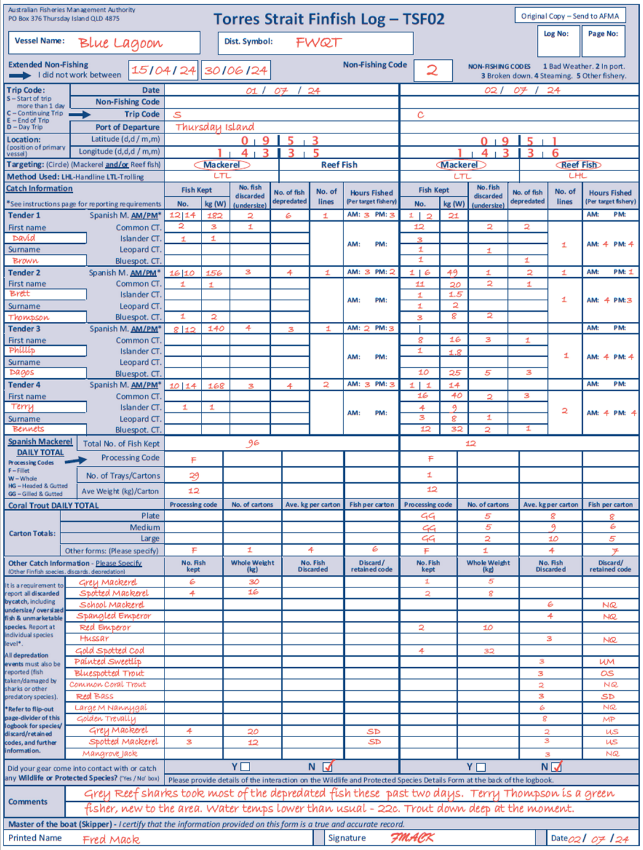
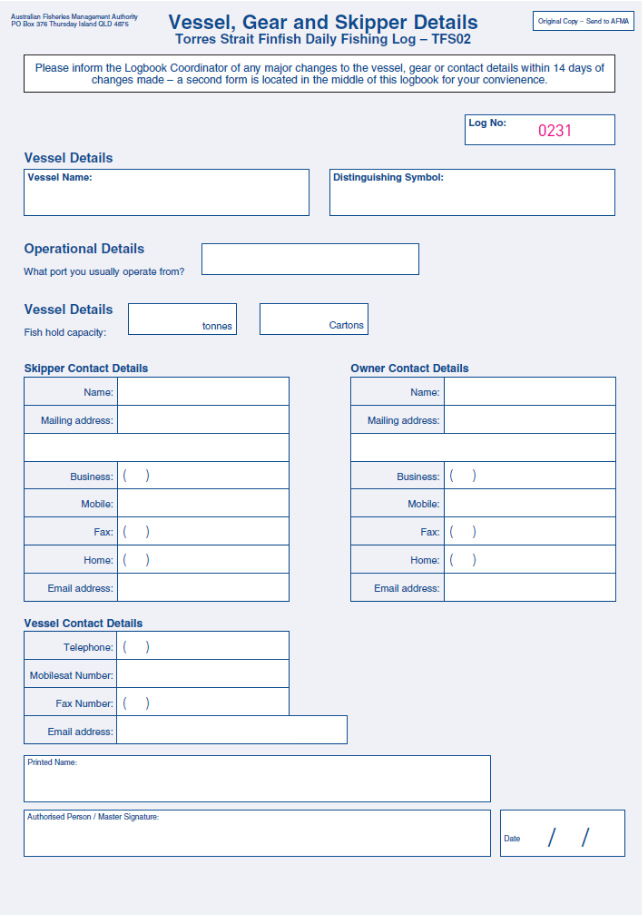
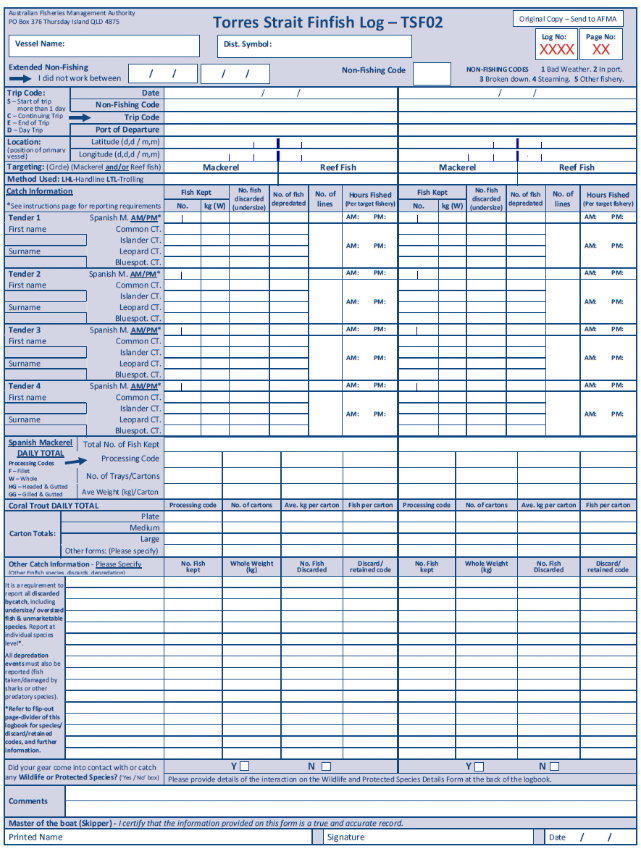
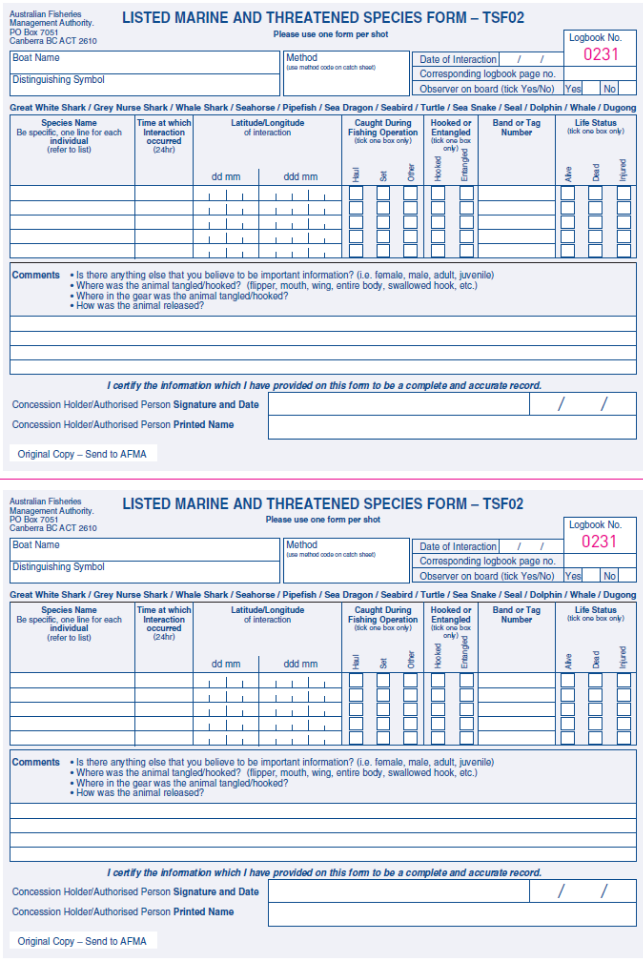
How to Measure Your Fish
(To ensure compliance with legal size limits)
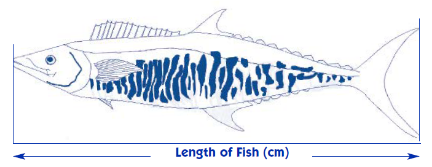
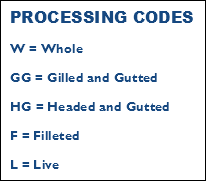
- Make sure mouth is closed;
- Measure the fish on its side, as soon as possible after capture;
- Finfish are measured from the point of the snout (or tip of the lower jaw, if that tip protrudes beyond the snout), to the extremity of the tail or caudal fin, whichever is longer.
DISCARD / RETAINED CODES
MP = Marketable species but it was considered uneconomical to land on this occasion.
NQ = Marketable species but no catch entitlement was held to land on this occasion.
US = Fish is below a regulated minimum size or it is a size that makes it unmarketable.
OS = Fish is above a regulated minimum size or it is a size that makes it unmarketable.
UM = Market place considers it to be inedible.
SD* = Shark damaged/depredated
* This code can be used for discarded or retained fish (e.g. if half a fish was retained).
SPECIES CODES*
MAO = School Mackerel
MAL = Spotted Mackerel
MAG = Grey/Broad Barred Mackerel
MSH = Salmon/Shark Mackerel
MAW = Tripletail Maori Wrasse
RDE = Red Emperor
SPE = Spangled Emperor
GSS = Stripey Snapper
BAM = Barramundi
HUS = Hussar
RSS = Large-mouthed nannygai
MNJ = Mangrove Jack
SRB = Red Bass
JOR = Rosey Snapper/Jobfish
VTU = Venus tuskfish
BKF = Black Kingfish/Cobia
Basket species
Report by species-basket if insufficient space on the log sheet to record all by-catch to species level. Prioritise reporting of discarded no-take species individually before utilizing basket codes/names. Basket classification include, but are not limited to the following:
RSE = Emperors (Family Lethrinidae)
SSB = Tropical Snappers (Lutjanus sp.)
Wrasses = Family Labridae
Cods/Gropers = Family Serranidae
*For species not listed, please record common name.
Don’t forget to insert this template under the log page you’re writing on
PLEASE REMEMBER
- The logbook must be filled out on the vessel during the course of the trip. All details must be completed on a daily basis and the logbook must be completed before the boat docks at the conclusion of each trip.
- You must account for every day that your fishing licence is in force, regardless of whether or not you fish on that day (see instructions for ‘extended non-fishing’ section).
- Logsheet(s) must be sent to AFMA within 3 days of the trip end date.
- It is your responsibility to ensure that you are aware of the catch limits and regulations for all species.
- The “Vessel, Gear, and Skipper Details” sheet must be completed and returned with your first catch sheet returns. A second “Vessel, Gear and Skipper Details" sheet is located in the middle of the logbook. This should be completed if the vessel, gear or skipper changes.
Listed Marine and Threatened Species List
Under the Environment Protection and Biodiversity Conservation Act 1999 the following species are listed as protected. This list is current at the date of publishing. For further information about Listed Marine and Threatened Species or to check updates to these lists please go to www.dcceew.gov.au.
Please be as specific as you can with regard to the species identification.
LISTED MARINE SPECIES
Fish
All species of Sygnathid (Pipefish, Seahorses & Sea Dragons)
Marine Reptiles
All species of Turtle, Sea Snake and Crocodile.
Seals
All species of Seal and Sea Lion.
Cetaceans
All species of Dolphin, Whale, Porpoise and Dugong.
Sea Birds
All species of Seabird.
THREATENED FISH SPECIES
Grey Nurse Shark (Carcharias taurus) – East and west coast population
Speartooth Shark (Glyphis sp. A)
Northern River shark (Glyphis sp. C)
Great White Shark (Carcharodon carcharias)
Freshwater Sawfish (Pristis microdon)
Whale Shark (Rhincodon typus)